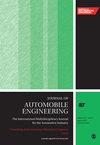Regenerative braking fault compensation control of distributed electric vehicle considering random wheel fault degree
IF 1.5
4区 工程技术
Q3 ENGINEERING, MECHANICAL
Proceedings of the Institution of Mechanical Engineers Part D-Journal of Automobile Engineering
Pub Date : 2024-08-28
DOI:10.1177/09544070241271761
引用次数: 0
Abstract
Distributed drive electric vehicles can reduce range anxiety through regenerative braking. However, if the wheel motor torque output fails, it will form an additional yaw moment to the vehicle, causing instability, or deviation and threatening its safety. To solve this problem, the research object is an electric vehicle driven by a four-wheel hub motor. A braking force compensation distribution strategy for front and rear axles is proposed, which combines electronic hydraulic braking (EHB) system compensation control and deviation auxiliary control. Firstly, a fault detection module is established, and the motor’s output torque is estimated by designing a torque observer to obtain the fault degree information of the motor. Secondly, to fully use the motor’s regenerative braking force, the fault-free and faulty electro-hydraulic braking force distribution strategies are designed in the coordinated distribution layer of the electro-hydraulic braking system. The corresponding electro-hydraulic braking force compensation method is selected according to the fault degree of the regenerative braking function, the position of the faulty wheel, and the braking strength. Then, a deviation auxiliary controller is designed based on the model predictive control, and the intervention time of the auxiliary controller is determined according to the vehicle’s state. Finally, the control method is verified based on CarSim/Simulink co-simulation and hardware-in-the-loop (HIL) platform. The test results show that the designed control method can effectively compensate for the regenerative braking failure of random wheel and ensure the braking safety of the vehicle.考虑随机车轮故障程度的分布式电动汽车再生制动故障补偿控制
分布式驱动电动汽车可以通过再生制动减少续航焦虑。但是,如果轮毂电机扭矩输出失效,就会对车辆形成额外的偏航力矩,导致车辆不稳定或偏离,威胁车辆安全。为解决这一问题,研究对象是由四轮轮毂电机驱动的电动汽车。提出了一种前后轴制动力补偿分配策略,该策略结合了电子液压制动(EHB)系统补偿控制和偏离辅助控制。首先,建立故障检测模块,通过设计扭矩观测器估算电机的输出扭矩,从而获得电机的故障程度信息。其次,为了充分利用电机的再生制动力,在电液制动系统的协调分配层设计了无故障和故障电液制动力分配策略。根据再生制动功能的故障程度、故障车轮的位置和制动强度,选择相应的电液制动力补偿方法。然后,基于模型预测控制设计偏差辅助控制器,并根据车辆状态确定辅助控制器的干预时间。最后,基于 CarSim/Simulink 协同仿真和硬件在环(HIL)平台对控制方法进行了验证。测试结果表明,所设计的控制方法能有效补偿随机轮的再生制动失效,确保车辆的制动安全。
本文章由计算机程序翻译,如有差异,请以英文原文为准。
求助全文
约1分钟内获得全文
求助全文
来源期刊

CiteScore
4.40
自引率
17.60%
发文量
263
审稿时长
3.5 months
期刊介绍:
The Journal of Automobile Engineering is an established, high quality multi-disciplinary journal which publishes the very best peer-reviewed science and engineering in the field.
 求助内容:
求助内容: 应助结果提醒方式:
应助结果提醒方式:


